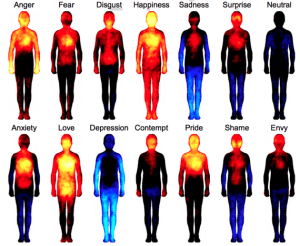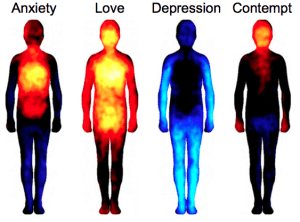Mapping How Emotions Manifest in the Body
“Across five experiments, 701 participants “were shown two silhouettes of bodies alongside emotional words, stories, movies, or facial expressions. They were asked to color the bodily regions whose activity they felt increasing or decreasing while viewing each stimulus.”
The emotions were generated by having the subjects read short stories or watch movies. On a blank, computerized figurine, they were then asked to color in the areas of their body where sensations became stronger (the red and yellow) or weaker (blue and black) when they felt a certain way.
The correlations between the subjects’ different body maps were strong—above .71 for each of the different stimuli (words, stories, and movies). Speakers of Taiwanese, Finnish, and Swedish drew similar body maps, suggesting that the sensations are not limited to a given language.
So what are we seeing in these illustrations? The authors note that, measured physiologically, most feelings only cause a minor change in heart rate or skin temperature—our torsos don’t literally get hot with surprise.
Instead, the results likely reveal subjective perceptions about the impact of our mental states on the body, a combination of muscle and visceral reactions and nervous system responses that we can’t easily differentiate. Feeling jealous may not truly make us red in the face, for example, but we certainly might feel like it does.”
Check out “Anger”; I’ve drawn body charts that are almost identical to that during examinations of people with chronic neck, back, upper limb pain and headaches.
I’ve also drawn body charts of whole arms and legs marked up and annotated “heavy, dead, aching”, almost a bit like “Depression”…
Before I’m accused of that nasty sin of conflating correlation with causation, I’m just asking, could there be a link here?
On a side note, the author of the article (not the research paper) states:
A new study by Finnish researchers published today in the Proceedings of the National Academies of Sciences, suggests that our emotions do indeed tend to influence our bodies in consistent ways.
I reckon Willam James may have had a thing to say about the “direction” of influence suggested by the statement, but that’s another blog post in itself.
– Tim Cocks
Get up to date and get your think on at a noigroup course



My brother died of a brain tumour age 49. Childhood wasn’t a happy event and expressions of emotions definitely not tolerated. He was rendered ” Speechless” !!!!! The tumour was aggressive taking six months to dispatch my dear brother. The tumour was situated in the speech centre of his brain – using old terminology………draw your own conclusions…….